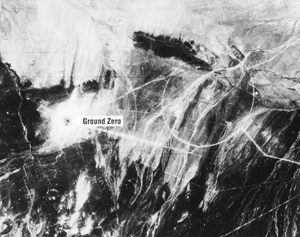
The IC split over China’s Lop Nor test site, too.
David Sanger details the debate over signs of possible North Korea nuclear test preparations. The key graf casts doubt on his earlier report North Korea had erected a “grandstand”:
Last week, three sources in different parts of the United States government told The New York Times that they had seen or been briefed on evidence of what looked like grandstands erected at a distance from the suspected test site, raising suspicions that preparations were in place for observers of a possible test. They acknowledged that even if there were grandstands, they could exist for another purpose.
But one agency cautioned at the same time that it knew of no evidence of any such structure. This week officials at the intelligence arm of the State Department expressed the same view. As written intelligence reports are usually shared among agencies, their inability to confirm the information was striking.
Some positions are shifting: a senior administratrion official who confirmed the presence of the grandstand last week said late Wednesday that he was now uncertain whether the structure was related to the test site. But he said he was more concerned than ever that the North might be tempted to test.
Because the issue of North Korea’s obtaining nuclear weapons is of such far-reaching importance, and because this kind of military intelligence is so highly sensitive, officials will describe the intelligence only very cautiously, each divulging only limited information, and none agreeing to be identified, or even to let their organizations be named.
Chris Nelson takes care of naming their organizations, describing the debate as DIA, which believes a test is likely, against CIA and INR, which do not:
… what’s the current thinking on whether or not there WILL be a test? Increasingly, our expert sources reluctantly conclude that the DPRK probably has a workable nuclear weapon. But as to whether the construction site revealed in Friday’s N.Y. Times story adds up to serious proof if intent … the jury is divided, and leaning toward “no conviction”. It is generally well-known in the expert community that US intelligence is split … and that State’s INR sides with those in the CIA who argue “no test”, while Administration hard liners are clearly being backed by DIA and DOD sources who think the satellite images show clear preparations for a test.
Sanger also notes that evidence of sealing the shaft is little more than a lot of vehicle activity:
Trucks have been moving in and out of the site for months, and lately some technical analysts have said they believe the trucks are bringing in material to fill a hole, sometimes a sign that an underground test site is being sealed up again. Others have reported similar evidence.
But the White House also warned of a possible test last October, because of similar activity, and was worried about the issue (though it said nothing publicly) during a spate of activity in January. Part of the problem, experts say, is that because North Korea has never conducted a test, no one understands whether its preparations look like the kind that were seen in the old Soviet Union or in China, both of which have helped North Korea’s program in years past.
Sanger’s description suggests, to me, the satellite evidence is insufficiently conclusive to expect a test.
In case you wonder just what Chinese test preparations looked like, the CIA long ago declassified Chances of an Imminent Communist Chinese Nuclear Explosion (Special National Intelligence Estimate SNIE 13-4-64, August 26, 1964). The intelligence community also split over that question, weighing clear preparations for a Chinese nuclear test against the widely held (and incorrect) belief that China lacked sufficient fissile material:
On the basis of new overhead photography, we are now convinced that the previously suspect facility at Lop Nor in Western China is a nuclear test site which could be ready for use in about two months. On the other hand the weight of available evidence indicates that the Chinese will not have sufficient fissionable material for a test of a nuclear device in the next few months. Thus, the evidence does not permit a very confident estimate of the chances of a Chinese Communist nuclear detonation in the next few months. Clearly the possibility of such a detonation before the end of this year cannot be ruled out—the test may occur during this period. On balance, however, we believe that it will not occur until sometime after the end of 1964.
In fact, the test occurred about three weeks later, using uranium enriched at the Lanzhou Gaseous Diffusion Plant.
Update: The Bulletin of Atomic Scientists has posted my article examining China’s “Ambigous Arsenal”.
